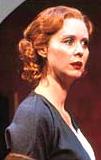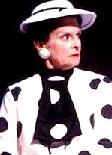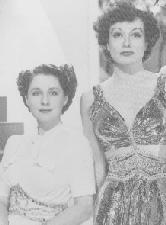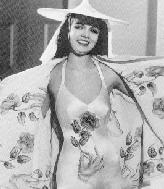SEARCH CurtainUp
REVIEWS
FEATURES
NEWS (Etcetera)
ADDRESS BOOKS
Broadway
Off-Broadway
BOOKS and CDs
OTHER PLACES
Berkshires
London
Los Angeles
Philadelphia
Elsewhere
QUOTES
On TKTS
LETTERS TO EDITOR
FILM
LINKS
MISCELLANEOUS
Free Updates
Masthead
NYC Weather
The Women
|
Nobody ever misses a clever woman
--- Nancy, the only career woman in Claire Booth Luce's sendup of Park Avenue matrons circa 1936 whose days revolve around shopping, bridge and "having orgasms by gossip." |

Cynthia Nixon
(Photo: Joan Marcus ) |
Before going into what blooms and what prickles, a quick rundown of who does what to whom, with the current actors listed along with their famous screen counterparts : Mary (Norma Shearer, now Cynthia Nixon) is still thrilled to be Mrs. Stephen Haimes after two children and twelve years of marriage when she discovers that her husband has fallen into the clutches of an ambitious shop girl named Crystal Allen (Joan Crawford, now Jennifer Tilly). Egged on by her not so well-meaning friends, especially chief scandal monger Sylvia Fowler (Rosalind Russell, now Kristen Johnston), Mary ignores mom's advice (Lucille Watson, now Mary Louis Wilson) to let the affair run its course. Consequently, she ends up in Reno, the erstwhile divorce capital. After two years as a not very gay divorcee, she is ready to shelf her pride and "grow claws" to do battle for her man -- a nail polish named jungle red being the defining metaphor for these women's battling like jungle cats over men.
Thanks to Luce's way with venom laced quotable dialogue and the impact of an all-female cast of over forty characters, The Women, especially the original stage script, retains a degree of entertainment value -- albeit mostly as a campy artifact of a specific era. Actually, even during the Great Depression when Luce's portrayal of a group of self-absorbed Manhattan society women made a social statement about working and leisure class women, the play was a hit mainly because of its stylish look and the tiger-sized cattiness on display.
While we are still spending plenty of time and money on looking good (which for most translates into young and thin), this has become a unisex thing. Adultery certainly hasn't gone away and we now have bright trophy wife instead of bimbos. But, for all this stuff about women as empty-headed, catty competitors to soar, its political incorrectness must be insouciantly polished to a high polymer shine.
That takes us to the thorns in the rose motif of Mr. Elliot's directorial vision. The first image of the cast is terrific, as is the accompanying music that introduces this and every other scene. Bookending this with a curtain call in which the full cast comes out in underwear may make sense considering that we've spent more than two hours watching these ladies reveal the not so pretty layers underneath all their finery -- but it's sense that comes at the sacrifice of sensibility. Even Mary Louise Wilson's slightly more dignified undies don't raise the dubious taste level of this final exit.

Mary Louise Wilson
(Photo: Joan Marcus ) |
Crystal is supposed to project the drive and ambition that make her as much the author's alter ego as Nancy the unmarried writer. Lisa Emery, who plays Nancy, fares better, especially since she gets some of the best lines. However, her first scene in a mannish pin stripe suit (to visually identify her as a Lesbian?) is another unsubtle and unnecessary touch. That brings us to the costumes which play a major part in this satire that is all about appearance.
To give Isaac Mizrahi his due, some of his hats and dresses are witty and attractive, but too many are outlandish and downright cruel to their wearers -- like the robe that seems designed to make Cynthia Nixon's legs look awful, or the grossly unflattering horizontally striped bathing suit he has her wear in Reno. The black and white oversized polka dot suit for Mary Louise Wilson may be fun, but it does little for the character of the dignified Mrs. Moorehead (played by Wilson with all the required dignity). What it does do is to make you yearn for the subtle touch of the Gilbert Adrian, the man who created the costumes for the film.

Norma Shearer & Joan Crawford --
similar gowns, different looks. (from Gowns by Adrian Harry N. Abrams Publishers ) |

Bathing costume by Adrian
(from Gowns by Adrian Harry N. Abrams Publishers ) |
Besides the already mentioned good and not so good character interpretations, the large cast is full of high caliber performances. Cynthia Nixon, while not as glamorous as Norma Shearer, brings real depth to the role of Mary. Jennifer Coolidge is the show's comic standout as the always pregnant Edith, with Rue McClainahan also very funny in the smaller roles of the much married Countess DeLage. While she doesn't show up until the second act, Lynn Collins is excellent as the play's second but more genial husband stealer and one suspects she would be a better Crystal.
Also coming up roses are the minor players who ably take on a variety of working women roles. In fact, one of the evening's strongest scenes is in the Haines kitchen in which two servants, Jane (Heather Matarazzo) and Maggie (Mary Band Davis) discuss the final blowup between their employers (Jane's "Why does she get so mad every time he says they've got to consider the children? " brings Maggie's philosophical "Marriage is a business of taking care of a man and rearing his children . . . it ain't meant to be no perpetual honeymoon").
Derek McLane's rolling sets work very well in taking us to the various locations. They are nicely detailed with props like an old permanent wave contraption straight out of a Rube Goldberg cartoon. Brian MacDevitt's lighting beautifully highlights the emotions flickering across Mary's face.
If the audience reaction at the performance I attended is any indication, these shallow back stabbers are more amusing to the men than the women. Regardless of sex, most viewers will forget these women faster than it would take for a coat of Jungle Red to dry. On the other hand, there's this from Wendy Wasserstein who, despite extolling women's friendships in Uncomnon Women, in a Playbill interview with the director: "I still think my life would be greatly improved if I could just sit at Crystal's feet and learn a little something. I feel like the women in this play know something my mother forgot to teach me." If you can get that "something" from a couple of hours at the American Airlines Theater, your ticket would be a bargain even if priced at $480 like those priority deals for The Producers.
For any fashionistas on your Christmas gift list you may want to consider the above mentioned book about Gilbert Adrian. Besides the chapter about the making of The Women it is chock full of gorgeous photos and background on the whole MGM glamour era. It' discounted through our book store:
Gowns by Adrian: The MGM Years 1928-1941
|
THE WOMEN
Written by Clare Boothe Luce Directed by Scott Elliott Starring (in alphabetical order): Lynn Collins (Miriam Aarons),Jennifer Coolidge (Edith), Hallie Kate Eisenberg (Little Mary), Lisa Emery (Nancy Blake), Kristen Johnston (Sylvia), Rue McClanahan (Countess De Lage) Cynthia Nixon (Mary), Amy Ryan (Peggy), Jennifer Tilly (Crystal Allen),Mary Louise Wilson (Mrs. Morehead); With (in multiple roles): Susan Bruce, Jennifer Butt, Jane Cronin, Jen Davis, Mary Bond Davis, Julie Halston, Roxanna Hope, Kelly Mares, Barbara Marineau, Heather Matarazzo, Adina Porter, Gayton Scott, Cheryl Stern, Ann Talman. Set Design: Derek McLane Costume Design: Isaac Mizrahi Lighting Design: Brian MacDevitt Musical arrangements and sound: Douglas J. Cuomo Dialect Coach: Stephen Gabis Running Time: 2 1/2 hours, including one intermission American Airlines Theater, 227 West 42nd Street (8th/9th Avs), Performances from 10/12/01-1/06/02; opening 11/08/01 Tues-Sat at 8pm with Wed, Sat, Sun matinees at 2 pm. Reviewed by Elyse Sommer based on 11/09/01 performance |

6,500 Comparative Phrases including 800 Shakespearean Metaphors by CurtainUp's editor.
Click image to buy.
Go here for details and larger image.



